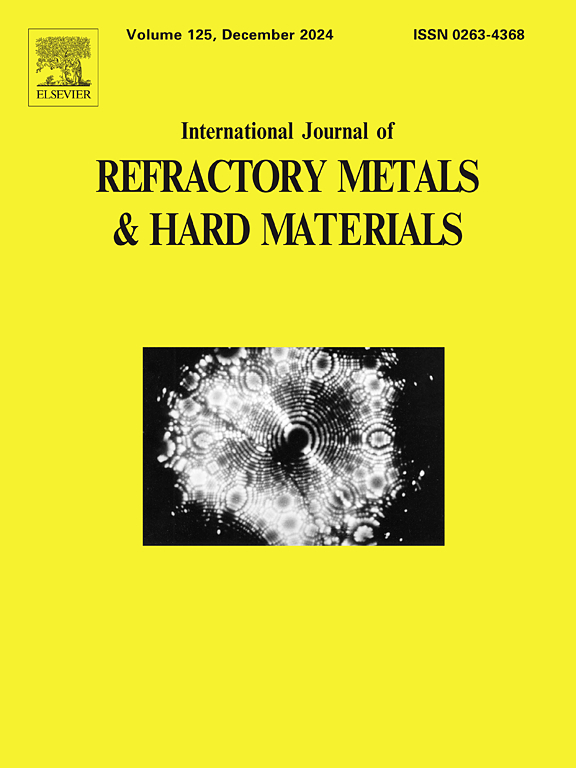Nb、TiNb和Ti衬底与液态Mg的高温相互作用比较研究
IF 4.2
2区 材料科学
Q2 MATERIALS SCIENCE, MULTIDISCIPLINARY
International Journal of Refractory Metals & Hard Materials
Pub Date : 2025-05-21
DOI:10.1016/j.ijrmhm.2025.107245
引用次数: 0
摘要
研究人员首次采用了固滴法来比较液态Mg与不同耐火衬底(包括纯Ti、Nb和TiNb合金(26 at))的高温相互作用。% Nb)。采用毛细管净化程序消除加热历史和天然氧化膜对Mg样品的影响。实验在700°C的等温条件下,在氩气和5% H2的保护气氛中进行。利用高温试验中捕获的Mg/衬底耦合图像来确定液态Mg滴与衬底之间形成的接触角(θ)。采用扫描电镜和能量色散x射线能谱对凝固后的Mg/Ti、Mg/Nb和Mg/Ti- 26nb熔滴进行了详细的结构表征。在所使用的实验条件下,所有被检查的偶都表现出非润湿行为(θ >;90°),凝固液滴与基底之间不会形成永久键,并且在高温相互作用过程中不会表现出它们之间的传质。液体Mg沉积180 s后,接触角的平均值为θMg/Nb = 124°,θMg/Ti- 26nb = 109°,θMg/Ti = 111°。根据MgNb和MgTi体系的相图,Mg/Nb、Mg/Ti和Mg/Ti- 26nb对的非润湿、非反应性和非成键行为可归因于MgNb和MgTi体系的不混溶性质,Nb或Ti在液态Mg中的溶解度可以忽略不计,以及Mg不与它们形成任何化合物。本文章由计算机程序翻译,如有差异,请以英文原文为准。
Comparative study of high-temperature interaction of Nb, TiNb, and Ti substrates with liquid Mg
For the first time, the sessile drop method was applied to compare the high-temperature interactions of liquid Mg with dissimilar refractory substrates, including pure Ti, Nb, and a Ti![]() Nb alloy (26 at.% Nb). A capillary purification procedure was employed to eliminate both the influence of heating history and the presence of native oxide films on the Mg samples.
Nb alloy (26 at.% Nb). A capillary purification procedure was employed to eliminate both the influence of heating history and the presence of native oxide films on the Mg samples.
The experiments were conducted under isothermal conditions at 700 °C in a protective atmosphere of Ar with 5 wt% of H2. The images of Mg/substrate couples captured during the high-temperature tests were used to determine the contact angles (θ) formed between the liquid Mg drop and the substrates.
The solidified sessile drop Mg/Ti, Mg/Nb, and Mg/Ti-26Nb couples underwent a detailed structural characterization using scanning electron microscopy and energy-dispersive X-ray spectroscopy.
Under the experimental conditions used, all examined couples exhibited non-wetting behavior (θ > 90°), did not form permanent bonds between solidified drops and the substrates, and did not show a mass transfer between them during high-temperature interaction. After 180 s of liquid Mg deposition, the average values of the contact angle were θMg/Nb = 124°, θMg/Ti-26Nb = 109°, and θMg/Ti = 111°. Following the phase diagrams available for the Mg![]() Nb and Mg
Nb and Mg![]() Ti systems, non-wetting, non-reactive, and no-bonding behavior of Mg/Nb, Mg/Ti, and Mg/Ti-26Nb couples can be attributed to the immiscible nature of the Mg
Ti systems, non-wetting, non-reactive, and no-bonding behavior of Mg/Nb, Mg/Ti, and Mg/Ti-26Nb couples can be attributed to the immiscible nature of the Mg![]() Nb and Mg
Nb and Mg![]() Ti systems, the negligible solubility of either Nb or Ti in liquid Mg, and the fact that Mg does not form any compounds with them.
Ti systems, the negligible solubility of either Nb or Ti in liquid Mg, and the fact that Mg does not form any compounds with them.
求助全文
通过发布文献求助,成功后即可免费获取论文全文。
去求助
来源期刊
CiteScore
7.00
自引率
13.90%
发文量
236
审稿时长
35 days
期刊介绍:
The International Journal of Refractory Metals and Hard Materials (IJRMHM) publishes original research articles concerned with all aspects of refractory metals and hard materials. Refractory metals are defined as metals with melting points higher than 1800 °C. These are tungsten, molybdenum, chromium, tantalum, niobium, hafnium, and rhenium, as well as many compounds and alloys based thereupon. Hard materials that are included in the scope of this journal are defined as materials with hardness values higher than 1000 kg/mm2, primarily intended for applications as manufacturing tools or wear resistant components in mechanical systems. Thus they encompass carbides, nitrides and borides of metals, and related compounds. A special focus of this journal is put on the family of hardmetals, which is also known as cemented tungsten carbide, and cermets which are based on titanium carbide and carbonitrides with or without a metal binder. Ceramics and superhard materials including diamond and cubic boron nitride may also be accepted provided the subject material is presented as hard materials as defined above.

 求助内容:
求助内容: 应助结果提醒方式:
应助结果提醒方式:


